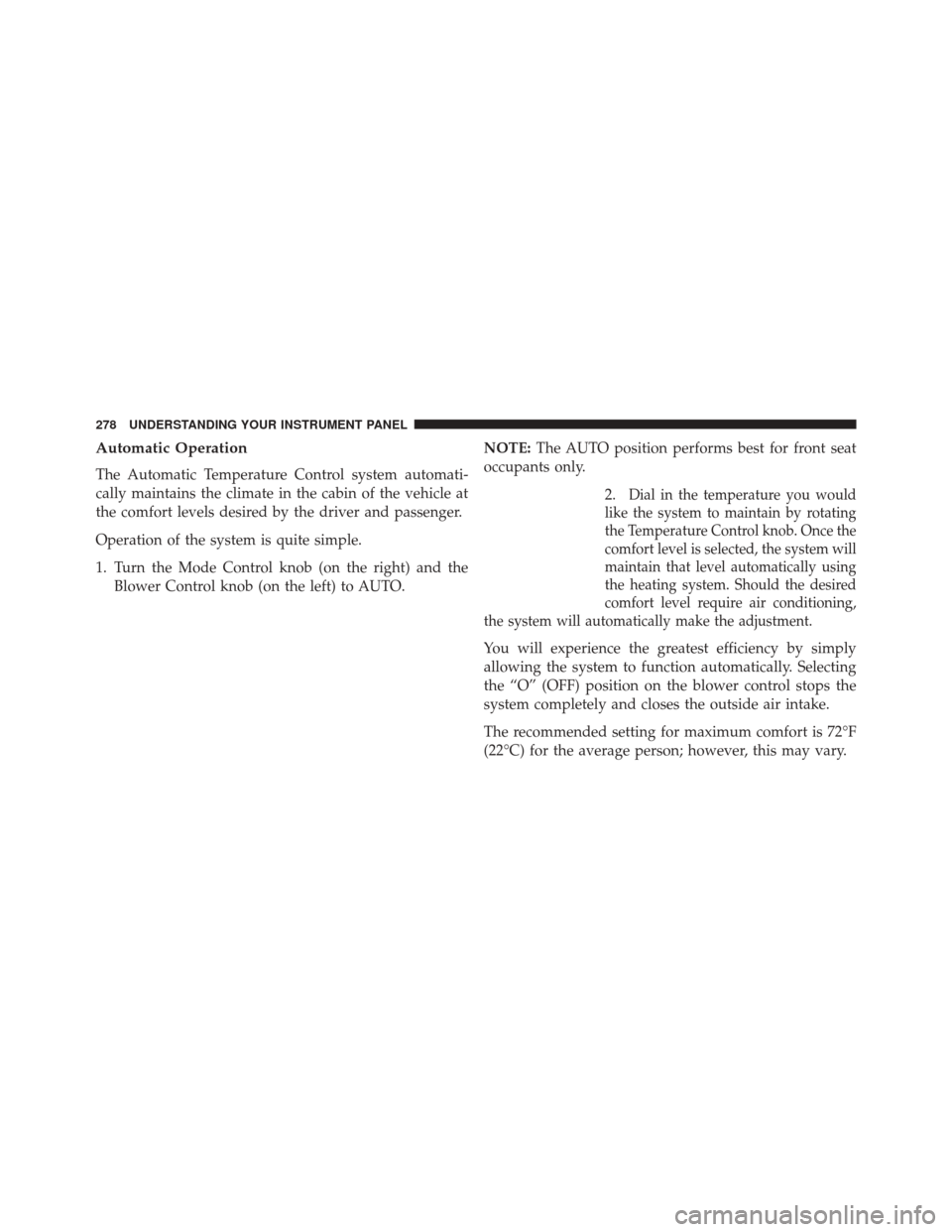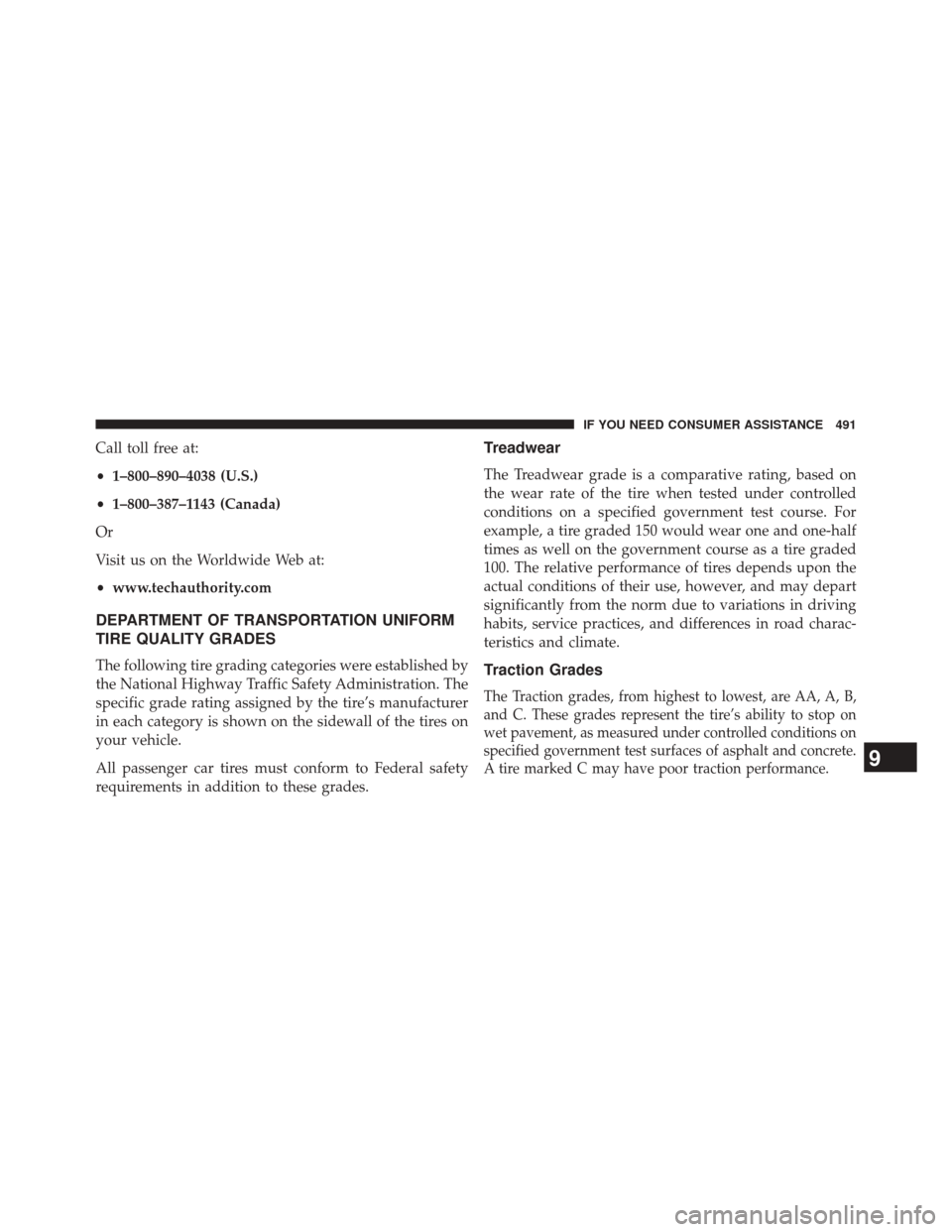Page 266 of 516

Connecting The iPod® Or External USB Device
Use the connection cable to connect an iPod® or external
USB device to the vehicle’s USB connector port which is
located in the center of the instrument panel below the
climate controls.Once the audio device is connected and synchronized to
the vehicle’s iPod®/USB/MP3 control system (iPod® or
external USB device may take a few minutes to connect),
the audio device starts charging and is ready for use by
pressing radio switches, as described below.
NOTE:
If the audio device battery is completely dis-
charged, it may not communicate with the iPod®/USB/
MP3 control system until a minimum charge is attained.
Leaving the audio device connected to the iPod®/USB/
MP3 control system may charge it to the required level.
Using This Feature
By using an iPod® cable, or an external USB device to
connect to the USB port:
• The audio device can be played on the vehicle’s sound
system, providing metadata (artist, track title, album,
etc.) information on the radio display.
USB Connector Port
264 UNDERSTANDING YOUR INSTRUMENT PANEL
Page 275 of 516
CLIMATE CONTROLS
The air conditioning and heating system is designed to
make you comfortable in all types of weather.
Manual Heating And Air Conditioning
The Manual Temperature Controls consist of a series of
outer rotary dials and inner push knobs.
Blower Control
Rotate this control to regulate the
amount of air forced through the venti-
lation system in any mode. The blower
speed increases as you move the control
to the right from the “O” (OFF) position.
There are four blower speeds.
NOTE:For vehicles equipped with Remote Start, the
climate controls will not function during Remote Start
operation if the blower control is left in the “O” (Off)
position.
Manual Temperature Control
4
UNDERSTANDING YOUR INSTRUMENT PANEL 273
Page 280 of 516

Automatic Operation
The Automatic Temperature Control system automati-
cally maintains the climate in the cabin of the vehicle at
the comfort levels desired by the driver and passenger.
Operation of the system is quite simple.
1. Turn the Mode Control knob (on the right) and theBlower Control knob (on the left) to AUTO. NOTE:
The AUTO position performs best for front seat
occupants only.
2.
Dial in the temperature you would
like the system to maintain by rotating
the Temperature Control knob. Once the
comfort level is selected, the system will
maintain that level automatically using
the heating system. Should the desired
comfort level require air conditioning,
the system will automatically make the adjustment.
You will experience the greatest efficiency by simply
allowing the system to function automatically. Selecting
the “O” (OFF) position on the blower control stops the
system completely and closes the outside air intake.
The recommended setting for maximum comfort is 72°F
(22°C) for the average person; however, this may vary.
278 UNDERSTANDING YOUR INSTRUMENT PANEL
Page 460 of 516
CavityCar-
tridge Fuse Mini
Fuse Description
2 — 20 Amp YellowBrake Vacuum
Pump
3 — 10 Amp RedCenter High
Mounted Stop
Light (CHMSL)/
Brake Switch
4 — 10 Amp RedIgnition Switch
5 — 20 Amp YellowTrailer Tow – If
Equipped
6 — 10 Amp RedPower Mirror
Switch/Climate
ControlsCavity Car-
tridge Fuse Mini
Fuse Description
7 — 30 Amp GreenIgnition Off Draw
(IOD) Sense 1
8 — 30 Amp GreenIgnition Off Draw
(IOD) Sense 2
9 40 Amp Green Battery Feed –
Power Seats – If
Equipped
10 — 20 Amp YellowInstrument Panel/
Power Locks/
Interior Lights
11 — 15 Amp Lt BlueSelectable Power
Outlet (Inside Cen-
ter Arm Rest)
458 MAINTAINING YOUR VEHICLE
Page 493 of 516

Call toll free at:
•1–800–890–4038 (U.S.)
• 1–800–387–1143 (Canada)
Or
Visit us on the Worldwide Web at:
• www.techauthority.com
DEPARTMENT OF TRANSPORTATION UNIFORM
TIRE QUALITY GRADES
The following tire grading categories were established by
the National Highway Traffic Safety Administration. The
specific grade rating assigned by the tire’s manufacturer
in each category is shown on the sidewall of the tires on
your vehicle.
All passenger car tires must conform to Federal safety
requirements in addition to these grades.
Treadwear
The Treadwear grade is a comparative rating, based on
the wear rate of the tire when tested under controlled
conditions on a specified government test course. For
example, a tire graded 150 would wear one and one-half
times as well on the government course as a tire graded
100. The relative performance of tires depends upon the
actual conditions of their use, however, and may depart
significantly from the norm due to variations in driving
habits, service practices, and differences in road charac-
teristics and climate.
Traction Grades
The Traction grades, from highest to lowest, are AA, A, B,
and C. These grades represent the tire’s ability to stop on
wet pavement, as measured under controlled conditions on
specified government test surfaces of asphalt and concrete.
A tire marked C may have poor traction performance.
9
IF YOU NEED CONSUMER ASSISTANCE 491
Page 498 of 516

Cellular Phone...........................110
Certification Label ........................ .375
Chains, Tire ............................ .353
Changing A Flat Tire ...................... .395
Chart, Tire Sizing ........................ .333
Check Engine Light (Malfunction Indicator Light) . .422
Checking Your Vehicle For Safety ...............95
Checks, Safety ............................95
Child Restraint ............................73
Child Safety Locks .........................34
Cigar Lighter ........................... .194
Clean Air Gasoline ....................... .364
Cleaning Wheels .............................. .452
Climate Control ......................... .273
Clock ................................. .236
Cold Weather Operation ....................293
Compact Disc (CD) Maintenance ..............272
Compact Spare Tire ....................... .348Compass
.............................. .222
Compass Calibration ...................... .230
Compass Variance ........................ .230
Computer, Trip/Travel ......................21
Connector UCI................................ .263
Universal Consumer Interface (UCI) ..........263
Console ............................... .160
Console, Floor .......................... .160
Contract, Service ......................... .487
Coolant Pressure Cap (Radiator Cap) ...........441
Cooling System .......................... .438
Adding Coolant (Antifreeze) ...............440
Coolant Capacity ...................... .471
Coolant Level ......................... .438
Disposal of Used Coolant .................442
Drain, Flush, and Refill ...................438
Inspection ........................... .442
Points to Remember .....................443
496 INDEX